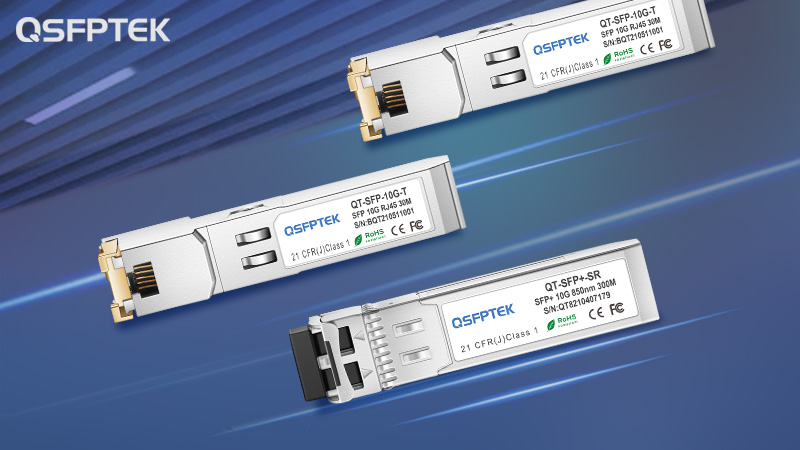History of Optical Transceivers and What Is an SFP Module
All details about the optical transceiver
what is a fiber transceiver used for?
The fiber optic transceiver is a vital part of the optical communication network, which is equivalent to the car on the highway, carrying the signal transmission. The photoelectric conversion chip of the optical module can perform the process of photoelectric signal conversion to convert the transmitted optical signal and the received optical signal into electrical signal data (ie 0 level and 1 level). An optical module consists of multiple devices: the receiving part ROSA and the transmitting part TOSA, the driving circuit, and the optical interface. There are many types of optical interfaces, including LC interface, SC interface, MTP interface, etc. You can connect optical cables, such as OM2\OM3\OM4, OS2 optical cables. Generally speaking, optical modules are used in pairs and can be installed in enterprise-class switches, routers or network cards with optical module ports.
Related article: SFP Connector Types & Wiki
The development of optic module

The original model of the optical module was a 1x9pin module with a maximum rate of 155Mbps. In 2000, after entering the millennium, the data room had a higher demand for transmission speed, so the GBIC module that could reach a rate of 1Gbps was born. GBIC modules provide various models, similar to the current SFP modules, including multiple types from SX to ZX, with transmission distances from 550m to 80km. Due to its large size, each switch can only have several GBIC interfaces. This is not conducive to high-density transmission. So people began to develop a new type of packaged optical module, hoping it would have a smaller size, higher rate and lower power consumption. In this way, the SFP module (Small-form factor pluggable) was born. It has more than double the volume and lower power consumption than GBIC. At the same time, 10G modules are packaged in two types: X2 and XENPAK. There are two types of 40G modules: CFP\CFP2. Compared to these modules, SFP has the smallest size.
In the next era, the development features of optical modules began to be developed towards the characteristics of small size and high rate. SFP+ package was born for 10G optical modules, which is almost the same as SFP, but can reach a high rate of 10Gpbs. 40G modules have been developed
CFP4 module, which doubles the volume of CFP. Then in 2013, the QSFP module was born. This module is twice the size of the CFP4 module, but has exactly the same performance.

Looking back at the development history of optical modules, we can clearly see that the rate of optical modules is getting higher and higher, and they are becoming more and more refined. This reflects the development of human technology and craftsmanship. It is incredible to develop from GBIC modules to QSFP28 modules in just 15 years. Today, in 2022, the 400G/800G module QSFP-DD joined the QSFP family. This explosive technological development has brought great changes to our lives.
Look back to SFP module
what is sfp transceiver and types of sfp

SFP optical module is also called mini-GBIC, which has the same functions as GBIC, but the size and the power consumption are greatly reduced . It has hot-swappable characteristics and can provide extremely high density in 1U space. Often a 1U switch device can be equipped with up to 48 SFP interfaces, which is much larger than the past GBIC modules. There are many types of SFP modules. Conventional SFP modules include SFP-1G-SX/SFP-1G-LX/SFP-1G-LH/SFP-1G-EX/SFP-1G-ZX/SFP-1G-EZX, these modules are equipped with LC duplex interface, The transmission distance covers from 500M to 120KM. In addition, there are some special models. BIDI SFP, this type of module is equipped with simplex LC interface or SC interface, which can be used with single fiber for transmission. The CWDM/DWDM SFP module has coarse wavelength division and dense wavelength division technology, and can perform high-capacity transmission on a pair of fibers with CWDM or DWDM mux demux. Depending on the device, the SFP DWDM module transmits up to 96 waves over a pair of fibers. All the above modules QSFPTEK are available at very competitive prices, welcome to the product catalog page to choose.
Related article: 2022 Best SFP Transceiver Buying Guide
Advantages of SFP module
We enumerated some of the advantages of SFP modules and found that these advantages are exactly what we need today:
-
The SFP module is compatible with many protocol standards, such as Ethernet, SONET SDH, and Fiber Channel.
-
There are many models of SFP modules, covering almost all usage scenarios. Even if the room wiring is only copper, you can choose SFP-1G-T or SFP-10G-T to work.
-
The SFP module has the DDM function of diagnostic monitoring, which can read the working parameters of the module, including receiving and transmitting optical signal power, working current, working voltage, working temperature, etc.
-
SFP modules are very small and suitable for high-density scenarios. Therefore it is also easy to install.
-
There is a pull ring at the front of the SFP package, and it is very simple to plug and unplug the SFP module, so the threshold is low.
-
The power consumption of SFP modules is lower than that of GBICs. For data centers, lower power consumption means lower electricity consumption and lower heat, which can save costs.
Conclusion
There is a lot of knowledge about optical modules, and QSFPTEK engineers will publish blogs an indefinite time to teach this knowledge. QSFPTEK has been working in the optical module industry for 11 years. Our philosophy is to serve global SMB users and bring high-quality and low-cost optical module products to everyone. QSFPTEK's goods can be shipped worldwide, if you are interested, please consult customer service. In addition, we also provide OTN optical network construction services, welcome to consult.











